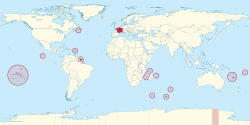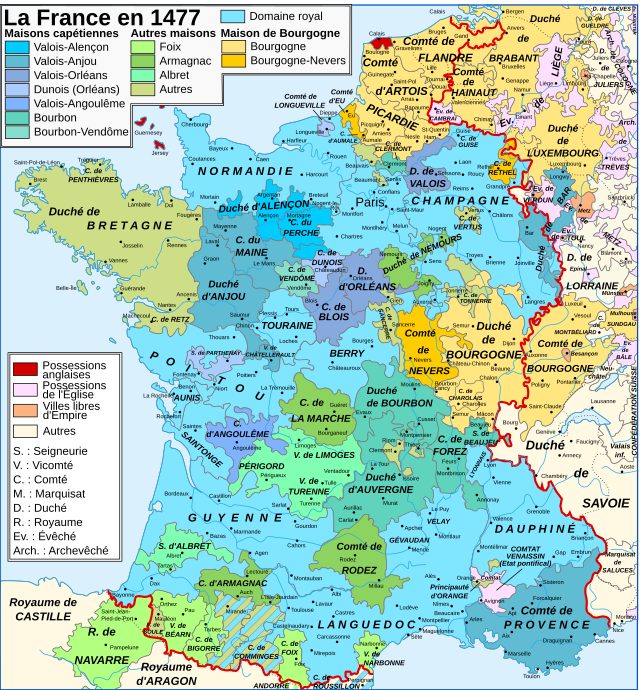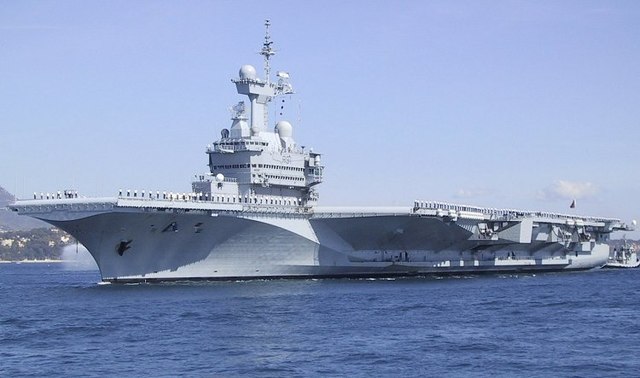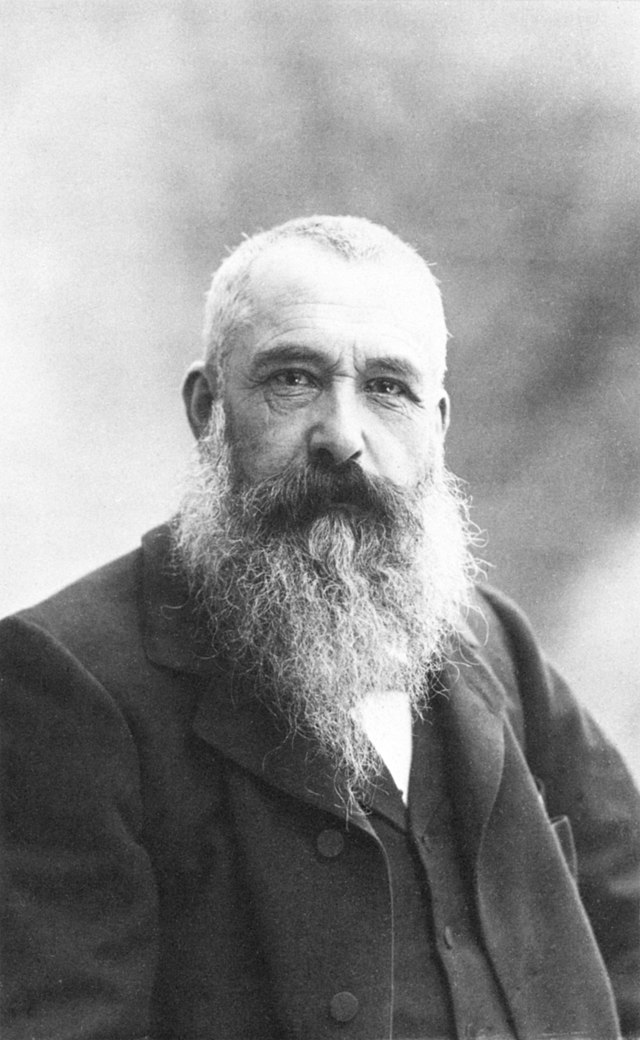country in Western Europe From Wikipedia, the free encyclopedia
France (![]() /ˈfræns/ (help·info) or /ˈfrɑːns/; French pronunciation: [fʁɑ̃s]), officially the French Republic (French: République française, French pronunciation: [ʁepyblik fʁɑ̃sɛz]), is a country in Western Europe. It also includes various departments and territories of France overseas.
/ˈfræns/ (help·info) or /ˈfrɑːns/; French pronunciation: [fʁɑ̃s]), officially the French Republic (French: République française, French pronunciation: [ʁepyblik fʁɑ̃sɛz]), is a country in Western Europe. It also includes various departments and territories of France overseas.
French Republic | |
|---|---|
| Motto: "Liberté, égalité, fraternité" "Liberty, Equality, Fraternity" | |
| Anthem: "La Marseillaise" | |
Location of metropolitan France (dark green) (Note the overseas department of French Guiana highlighted on the extreme lefthand side of the globe image.)– on the European continent (green & dark grey) | |

| |
| Capital and largest city | Paris 48°51′N 2°21′E |
| Official language and national language | French[upper-roman 1] |
| Nationality (2018) |
|
| Religion (2017[1]) |
|
| Demonym(s) | French |
| Government | Unitary semi-presidential constitutional republic |
| Emmanuel Macron | |
| Michel Barnier | |
| Gérard Larcher | |
| Yaël Braun-Pivet | |
| Legislature | Parliament |
| Senate | |
| National Assembly | |
| Establishment | |
| 25 December 496 | |
| August 843 | |
• Republic established | 22 September 1792 |
| 1 January 1958 | |
| 4 October 1958 | |
| Area | |
• Total | 640,679 km2 (247,368 sq mi) |
| 551,695 km2 (213,011 sq mi) | |
• Metropolitan France (Cadastre) | 543,940.9 km2 (210,016.8 sq mi) |
| Population | |
• Feb 2022 estimate | |
• Density | 104/km2 (270/sq mi) (106th) |
• Metropolitan France, estimate as of June 2020 | |
• Density | 116/km2 (300.4/sq mi) (89th) |
| GDP (PPP) | 2019 estimate |
• Total | |
• Per capita | |
| GDP (nominal) | 2019 estimate |
• Total | |
• Per capita | |
| Gini (2018) | low |
| HDI (2018) | very high · 26th |
| Currency |
|
| Time zone | UTC+1 (Central European Time) |
| UTC+2 (Central European Summer Time[upper-roman 9]) | |
| Note: various other time zones are observed in overseas France.[upper-roman 10]
| |
| Date format | dd/mm/yyyy (AD) |
| Driving side | right |
| Calling code | +33[upper-roman 11] |
| ISO 3166 code | FR |
| Internet TLD | .fr[upper-roman 12] |
Website www | |
Source gives area of metropolitan France as 551,500 km2 (212,900 sq mi) and lists overseas regions separately, whose areas sum to 89,179 km2 (34,432 sq mi). Adding these give the total shown here for the entire French Republic. The World Factbook reports the total as 643,801 km2 (248,573 sq mi).[9] | |
Mainland France extends from the Mediterranean Sea to the English Channel and the North Sea, and from the Rhine to the Atlantic Ocean. It is sometimes referred to as L’Hexagone ("The Hexagon") because of the shape of its territory.
France is a unitary semi-presidential republic. The head of state is the President, who is also a politician. The Prime Minister is secondary to the President.
Metropolitan France is bordered (clockwise from the North) by Belgium, Luxembourg, Germany, Switzerland, Italy, Monaco, Andorra, and Spain. The overseas departments and collectives of France share land borders with Brazil and Suriname (bordering French Guiana), and the Netherlands Antilles (bordering Saint Martin). France is linked to the United Kingdom by the Channel Tunnel, which passes under the English Channel.
France is the largest country in the European Union and the second largest in Europe. It has been one of the world's most powerful countries for many centuries. During the 17th and 18th centuries, France colonized much of North America. During the 19th and early 20th centuries, France built one of the largest colonial empires of the time. This included large parts of North, West and Central Africa, Southeast Asia, and many Pacific Islands. France is a developed country and has a large economy.[10]
It is the most visited country in the world, with 82 million foreign visitors every year.[11]
France was one of the first members of the European Union, and has the largest land area of all members. It is also a founding member of the United Nations, and a member of the Francophonie, the G8, NATO, and the Latin Union. It is one of the five permanent members of the United Nations Security Council. France has the largest number of nuclear weapons with active warheads, and the largest number of nuclear power plants, in the European Union.
France's official language is French, which is also official in 29 other countries. Some other French speaking countries include the Congo, Algeria, and Mauritius.
An interesting fact is that the French King Louis XIX only enjoyed 20 minutes of royal fame from the time his father Charles X abdicated, and the time the July Monarchy started in 1830.
France is in Western Europe.[12] France shares its borders with Belgium, Luxembourg, Germany, Switzerland, Italy, Monaco, Andorra, and Spain.[13] France has two mountain ranges near its borders: the Alps in the east and the Pyrenees in the south.[13] The climate of southern France is similar to Algeria which both have Mediterranean climate. There are many rivers in France, including the Seine and the Loire.[14] In the north and the west of France, there are low hills and river valleys.
In France there are many different climates.[15] The Atlantic has a major effect on the weather in the north and west. This means the temperature is about the same most of the year. It is in the marine west coast climate region. In the east, winters are cold and the weather is good. Summers are hot and stormy. In the south, winters are cool and wet. Summers are hot and dry.[16] The north has a temperate climate similar to that of the United Kingdom and other Northern European countries.
France has the second-largest exclusive economic zone (EEZ) in the world.[17] It covers 11,035,000 km2 (4,260,637 sq mi). Only the United States has a larger one.
The name "France" comes from the Latin word Francia ', which means "land of the Franks".[18]
The borders of modern France are about the same as those of ancient Gaul. Celtic Gauls inhabited Ancient Gaul. Julius Caesar conquered Gaul for Rome in the 1st century BC.[19] Eventually, the Gauls adopted Roman speech (Latin, from which the French language evolved) and Roman culture. Christianity first appeared in the 2nd and 3rd centuries AD. It became firmly established by the fourth and fifth centuries.

In the 4th century AD, the Germanic tribes, principally the Franks invaded the Gauls. This is how the name Francie appeared. The modern name "France" comes from the name of the Capetian Kings of France around Paris. The Franks were the first tribe of Europe after the fall of the Roman Empire to convert to Christianity rather than Arianism. The French called themselves "the most Christian Kingdom of France".[20]
The Treaty of Verdun (843), divided Charlemagne's Empire into three parts.[21] The biggest area was Western Francia. It is similar to modern France.
The Carolingian dynasty ruled France until 987, when Hugh Capet became King of France. His descendants, the Direct Capetians, the House of Valois and the House of Bourbon, unified the country with many wars and dynastic inheritance.
The monarchy was the most powerful during the 17th century and the reign of Louis XIV of France.[22] At that time, France had the largest population in Europe. The country had a big influence over European politics, economy, and culture. French became the common language of diplomacy in international affairs. Much of the Enlightenment happened in France. French scientists made big scientific discoveries in the 18th century. France also conquered many overseas possessions in the Americas and Asia.[23]
France had a monarchy until the French Revolution in 1789. King Louis XVI and his wife, Marie Antoinette, were executed in 1793.[24] Thousands of other French citizens were killed. Napoleon Bonaparte took control of the Republic in 1799. He later made himself Emperor of the First Empire (1804–1814). His armies conquered most of continental Europe.[25] The metric system was invented by French scientists during the French revolution. That time 3 estates were developed.
After Napoleon's final defeat in 1815 at the Battle of Waterloo, another monarchy arose. Later Louis-Napoléon Bonaparte created the Second Empire in 1852. Louis-Napoléon was removed after the defeat in the Franco-Prussian war of 1870. The Third Republic replaced his regime.[26]
The large French colonial empire in the 19th century included parts of West Africa and Southeast Asia. The culture and politics of these regions were influenced by France. Many ex-colonies officially speak the French language.[27]
The country actively took part in both the First and Second World Wars, with battles taking place on its soil. During the First World War, millions were killed in the trenches including over a million in the Battle of the Somme.[28] The conditions were extremely difficult for the soldiers on the front. The last surviving veteran was Pierre Picault who died on 20 November 2008 at the age of 109.[29]
During the Second World War, Nazis occupied France. The Allies landed in Normandy on 6 June 1944 and began the Battle of Normandy. German forces lost France in just a few months.
The 13 regions and 96 departments of metropolitan France include Corsica. France is divided into (administrative) regions:
Corsica has a different status than the other 12 metropolitan regions. It is called collectivité territoriale.
France also has five overseas regions:
These five overseas regions have the same status as the metropolitan ones. They are like the overseas American states of Alaska and Hawaii.
Then France is divided into 101 departments. The departments are divided into 342 arrondissements. The arrondissements are re-divided into 4,032 cantons. The smallest subdivision is the commune (there are 36,699 communes). On 1 January 2008, INSEE counted 36,781 communes in France. 36,569 of them are in metropolitan France and 212 of them are in overseas France.[30][31]
The government of France is a semi-presidential system determined by the constitution of the French Fifth Republic.[32] It provides for a separation of powers.[33]
The main ideals are expressed in the Declaration of the Rights of Man and of the Citizen. The constitution declares the nation to be "an indivisible, secular, democratic, and social Republic". With a Prime Minister subordinate to the President, this slightly strange system was chosen by General Charles de Gaulle in 1958.


The French armed forces has four branches:
France has about 359,000 military personnel.[34][35] France spends 2.6% of its gross domestic product (GDP) on defense. This is the highest in the European Union. France and the UK spend 40% of the EU defence budget. About 10% of France's defence budget is for its nuclear weapons force.
France is a member of the United Nations.[36] It is a permanent member of the United Nations Security Council and has veto rights.[37] It is also a member of the World Trade Organisation (WTO). It hosts the headquarters of the OECD, UNESCO and Interpol. In 1953, the United Nations asked France to choose a coat of arms to represent them internationally. The French emblem is now on their passports.
France was a founding member of the European Union.[38] In the 1960s, France wanted to exclude the United Kingdom from the organisation. It wanted to build its own economic power in continental Europe. France and Germany became closer after World War II. This was to try to become the most influential country in the EU. It limited the influence of the new Eastern European members. France is a member of the North Atlantic Treaty Organisation (NATO).[39] However, under President de Gaulle, it left the joint military command. In the early 1990s, France received criticism for its underground nuclear tests in French Polynesia. France vigorously opposed the 2003 invasion of Iraq.[40] France retains strong political and economic influence in its former African colonies. For instance it has supplied economic aid and troops for peace-keeping missions in the Ivory Coast and Chad.

France is a member of the G8 group of leading industrialised countries. France has the eighth-largest economy in the world by Gross domestic product (GDP) (which takes into account how much it costs to live in different countries and inflation rates).[41] France and 11 other European Union members jointly launched the euro on 1 January 1999 and started using it in 2002.[42]
France's economy has nearly 2.9 million registered companies.[43] The government has a considerable influence over railway, electricity, aircraft, and telecommunications firms (as it owns big companies like SNCF and EDF (French electricity)).[44] France has an important aerospace (design of aircraft and spacecraft) industry led by Airbus.[45] It can also launch rockets from French Guiana.[46]
France has invested a lot in nuclear power. This made France the smallest producer of carbon dioxide among the seven most industrialised countries in the world.[47] As a result, 59 nuclear power plants generate most of the electricity produced in the country (78% in 2006,[48] up from only 8% in 1973, 24% in 1980, and 75% in 1990).
France is the leading agricultural producer and exporter in Europe.[49] France exports wheat, poultry, dairy products, beef, and pork. It is also famous for its wine industry. France received 10 billion euros in 2006 from the European Community as subsidies to its farmers.[50]
At one time, the Factory Act of 1833 limited the workday for women and children to 11 hours a day.[51]

On 1 January 2008, it was estimated that 63.8 million people live in France, including in the Overseas Regions of France.[52] 61,875,000 of these live in metropolitan France, the part of the country that is within Europe.[52]
The major ethnic groups living in France today are descended from Celtic people and Roman people.[53] The significant minority groups living in France are:

French is the official language of France. It belongs to the Romance language group, which includes Italian and Spanish. Many regional dialects are also used in France. Alsatian, a German dialect, is spoken in Alsace and in parts of Lorraine in eastern France. French was the language of diplomacy and culture in Europe between the 17th and 19th century and is still widely used.[54]
Some people in France also speak Basque, Breton, Catalan, Corsican, German, Flemish, and Occitan.
There is around 200,000 Romani speakers in France, 950,000 speakers of different Arabic dialects (plus 220,000 occasional speakers) and 1.5 – 2 million speakers of different Berber dialects.[55]
France is a secular country and the constitution guarantees freedom of religion.[56] The population is about 51% Roman Catholic, and 31% of people are agnostics or atheists. 5% are Muslim, 3% say they are Protestant and 1% say they are Jewish. 10% are from other religions or do not have an opinion about religion.[57][58] There are also Zoroastrian, Unitarian Universalist, Jain and Wiccan communities. Religions founded in France include Raelism.
According to a Poll in 2007:[59]

French literature began in the Middle Ages.[60] French was divided into several dialects at the time. Some authors spelled words differently from one other.
During the 17th century, Pierre Corneille, Jean Racine, Molière, Blaise Pascal and René Descartes were the main authors.[61]
In the 18th and 19th centuries, French literature and poetry reached its best. The 18th century saw writings of authors, essayists and moralists as Voltaire and Jean-Jacques Rousseau. As for French children's literature in those times, Charles Perrault wrote stories such as "Little Red Riding Hood", "Beauty and the Beast", "Sleeping Beauty" and "Puss in Boots".[62]
Many famous French novels were written in the 19th century by authors such as Victor Hugo, Alexandre Dumas and Jules Verne. They wrote popular novels like The Three Musketeers, The Count of Monte-Cristo, Twenty Thousand Leagues Under the Sea, The Hunchback of Notre-Dame and Les Misérables. Other 19th century fiction writers include Emile Zola, Guy de Maupassant, Théophile Gautier and Stendhal.[63]
Famous novels were written during the 20th century by Marcel Proust, Antoine de Saint-Exupéry, Albert Camus, Jean-Paul Sartre and Michel Houellebecq.

The Tour de France cycling race in July is one of the best-known sporting events.[64] It is a three-week race of around 3,500 km that covers most of France and ends in the centre of Paris, on the Avenue des Champs-Elysées. Football is another popular sport in France. The French team won the FIFA World Cup in 1998 and 2018. They also won the UEFA European Football Championship in 1984 and 2000. France also hosts the 24 Hours of Le Mans car race. France also hosted the Rugby World Cup in 2007 and finished fourth.[65] France is closely associated with the Modern Olympic Games. At the end of the 19th century, the Baron Pierre de Coubertin suggested having the Olympic Games again. France hosted the Summer Olympics twice, in 1900 and 1924, in Paris. France will host the Summer Olympics in 2024, in Paris. France also hosted the Winter Games three times: in 1924 in Chamonix, in 1968 in Grenoble, and in 1992 in Albertville.

French cuisine has influenced the style of cooking throughout Europe, and its chefs work in restaurants throughout the world.[66]
The roots of modern haute cuisine lie in chefs like La Varenne (1615–1678) and the notable chef of Napoleon, Marie-Antoine Carême (1784–1833). These chefs developed a lighter style of food compared to the food of the Middle Ages. They used fewer spices, and more herbs and creamy ingredients.
Typical ingredients like roux and fish stock, and techniques such as marinading, and dishes such as ragout, were invented. Carême was an expert pâtissier (pastry-maker), and this is still a mark of French cooking. He developed basic sauces, his 'mother sauces'; he had over a hundred sauces in his repertoire, based on the half-dozen mother sauces.
French cuisine was introduced in the 20th century by Georges Auguste Escoffier (1846–1935). He was a genius at organisation. He worked out how to run large restaurants, as in a big hotel or a palace; how the staff should be organised; how the menu was prepared. He had methods for everything. Escoffier's largest contribution was the publication of Le Guide Culinaire in 1903, which established the fundamentals of French cookery. Escoffier managed the restaurants and cuisine at the Savoy Hotel and Carlton Hotel in London, the Hôtel Ritz Paris, and some of the greatest cruise ships.
Escoffier, however, left out much of the culinary character to be found in the regions of France.
Gastro-tourism and the Guide Michelin helped to make people familiar with the rich bourgeois and peasant cuisine of the French countryside in the 20th century. Gascon cuisine has also had great influence over the cuisine in the southwest of France. Many dishes that were once regional have become common all over the country. Cheese and wine are a major part of the cuisine, playing different roles regionally and nationally.[67][68][69] In the north of France, people often prefer to use butter to cook. In the south, they prefer olive oil and garlic.[70] In France, each region has its own special dish; choucroute in Alsace, quiche in Lorraine, cassoulet in the Languedoc-Roussillon, and tapenade in Provence-Alpes-Côte d'Azur.
In November 2010, French gastronomy was added by UNESCO to its lists of the world's 'intangible cultural heritage'.[71][72]


France is the number one tourist destination in the world. In 2007, 81.9 million foreign tourists visited France.[73] Spain comes second (58.5 million in 2006) and the United States comes third (51.1 million in 2006). Some of the most famous attractions in Paris, are the Eiffel Tower and the Arc de Triomphe. Another one is Mont Saint Michel, in Normandy.[74]
A European Disneyland is located in a suburb east of Paris. The resort opened in 1992 and is also a popular tourist destination in Europe.
Seamless Wikipedia browsing. On steroids.
Every time you click a link to Wikipedia, Wiktionary or Wikiquote in your browser's search results, it will show the modern Wikiwand interface.
Wikiwand extension is a five stars, simple, with minimum permission required to keep your browsing private, safe and transparent.